When deep fried vegetables are soaked in a soy sauce flavoured broth, the vegetables absorb the flavour from the broth and transform into a delicious dish. Although deep fried, Fried Vegetables in Broth is not oily at all.
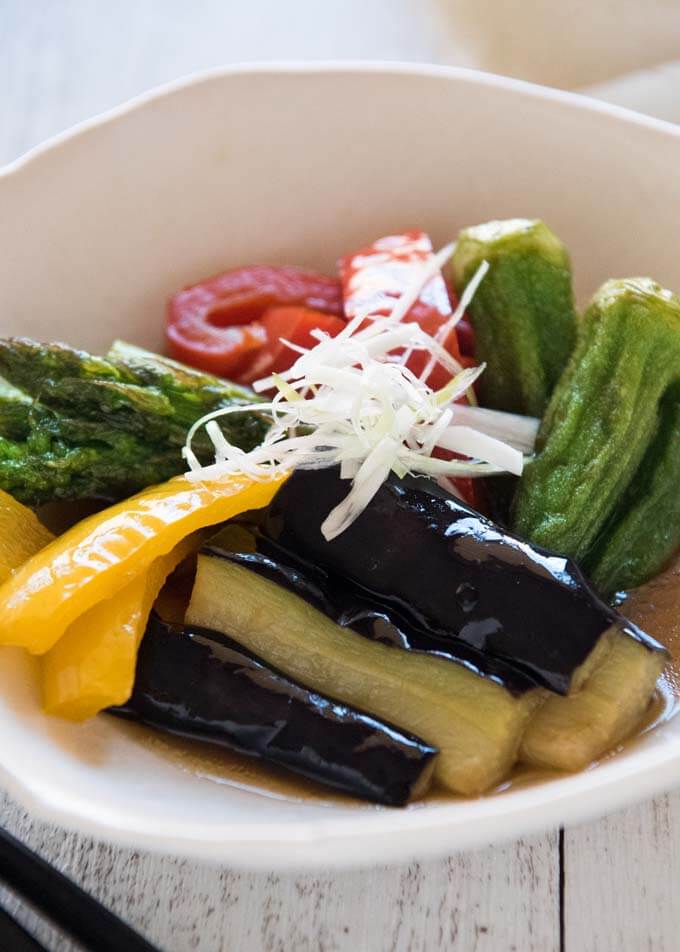
Fried Vegetables in Broth (Vegetables Agebitashi) is similar to the Western-style dish Marinated BBQ Vegetables from RecipeTin Eats. But the vegetables are deep-fried, and the marinade is a soy-flavoured dashi stock, not an oil-based marinade.
About Agebitashi
I posted Snow Pea Leaves Warm Salad (Nibitashi) some time ago. I explained in the post that Nibitashi (煮浸し) means cook and immerse.
Today’s Agebitashi (揚げ浸し) is a similar technique. But instead of cooking the ingredients in the broth and soaking them, deep fry the ingredients then soak them in the broth.
Deep frying adds a small amount of oil to the broth, making it a little bit richer and flavoursome.
Deep Frying without coating – Su-age (素揚げ)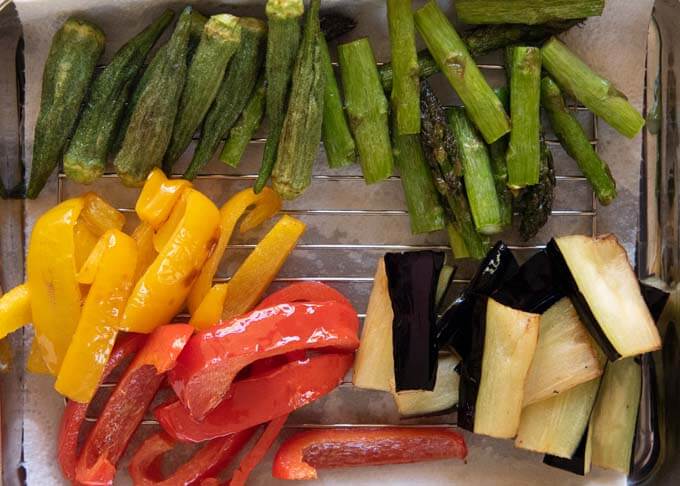
When frying vegetables for Agebitashi, they are not coated with flour or batter. The vegetables are deep fried with nothing around them. This method of frying ingredients is called ‘su-age’ (素揚げ), which means bare (su, 素) deep frying (age, 揚げ).
By doing su-age, the flavour of the vegetables intesify, making all the vegetables taste better.
This is because more moisture within the ingredients reduces when deep fried without coating. As a result of this, you can taste the stronger natural flavour of the ingredients. Besides, everything deep fried is tasty, right?
Broth for Agebitashi
This broth is very similar to the broth used in my recipe Snow Pea Leaves Warm Salad (Nibitashi). It is made up of dashi stock, soy sauce, mirin and salt.
I used normal soy sauce instead of light soy sauce to give a slightly stronger soy flavour. You can also adjust the amount of seasonings to suit to your palate. If you like a saltier flavour, increase the soy sauce or add a bit of salt to the broth. You can increase the mirin to make it a bit sweeter, too.
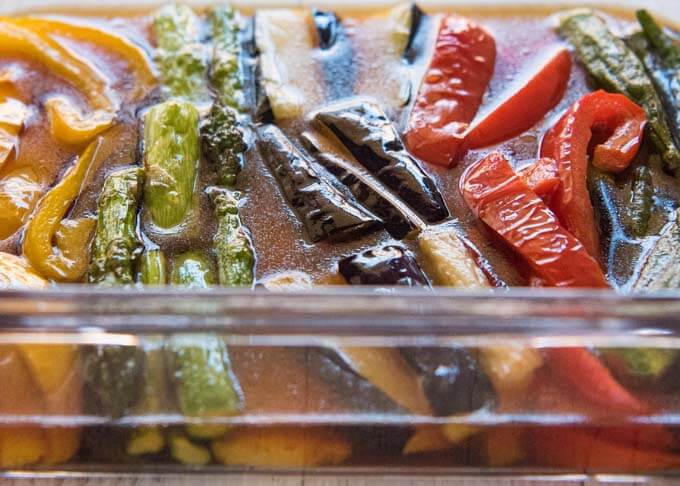
Vegetables Suited To Fried Vegetables in Broth
Almost any vegetables that can be deep fried are OK to use. But I tend not to use leafy vegetables such as cabbage, Chinese cabbage/nappa cabbage.
Today I used okra, asparagus, eggplant, red capsicum and yellow capsicum. I picked them to have varieties of colours.
Other vegetables that I suggest you use for Agebitashi dish are:
Green – green beans, zucchini, green capsicum
Yellow – yellow squash, pumpkin
Red/orange – Bullhorn chillies, mini tomatoes, sweet potatoes
White – lotus root, potato, King oyster mushrooms
Brown – Shiitake mushrooms, burdock
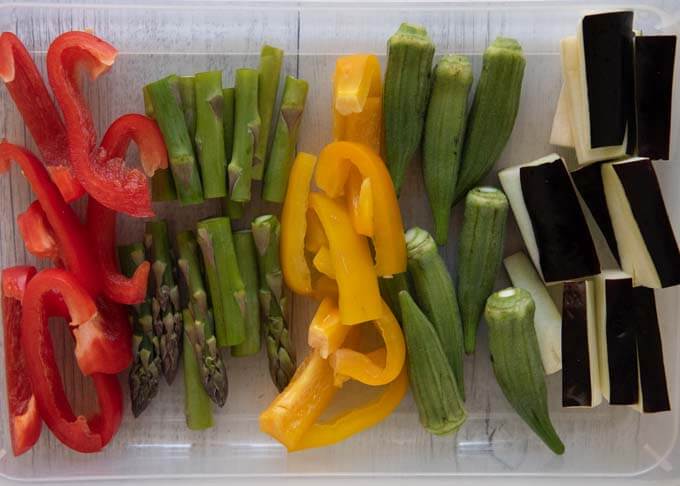
It is also OK to make Agebitashi with just one ingredient. Eggplant Agebitashi is actually quite a popular dish. Eggplant Agebitashi might look similar to Japanese Fried Eggplant (Agedashi Nasu). The difference is that the eggplants are marinated after deep-fried in the case of Agebitashi, but Agedashi Nasu is made by pouring hot dashi sauce over the deep-fried eggplants.
Preparation of Vegetables
Once the vegetables are sliced and prepared, it takes few minutes to fry them. I simply cut the vegetables into thin strips to match with the shape of the okra. I spent a little bit more time to prepare the okra.
The stem-end of the okra needs to be trimmed off as it is usually blackish. I also run my knife around the stem end, where the stem and the pod meet and remove the black line around the top of the pod. See the photo below showing okra before and after removing the black lines (left pile and right pile respectively).
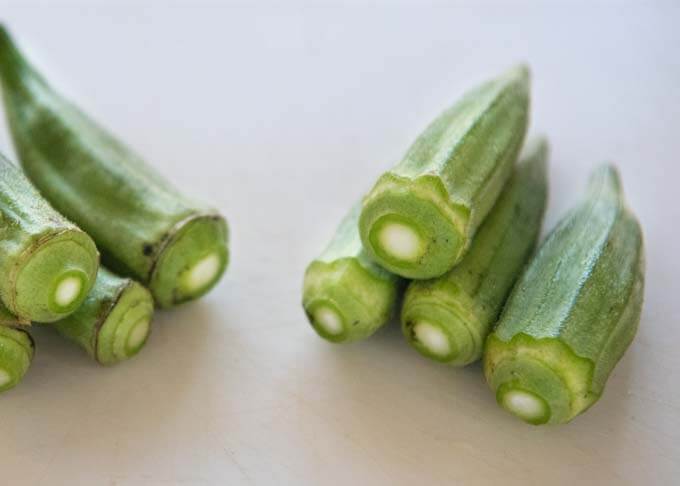
You also need to stab the side of the pod to make a tiny incision. This prevents the pod from exploding when heated.
The shape of the vegetables does not have to be like my dish. You can cut the vegetables into different shapes if you wish.
Fried Vegetables in Broth keeps a few days in the fridge. It is a handy side dish or salad that you can prepare ahead of time.
Fried Vegetables in Broth are also like Japanese version of marinated vegetables that go onto antipasto platters. It’s just that the vegetables are lighter and not as oily.
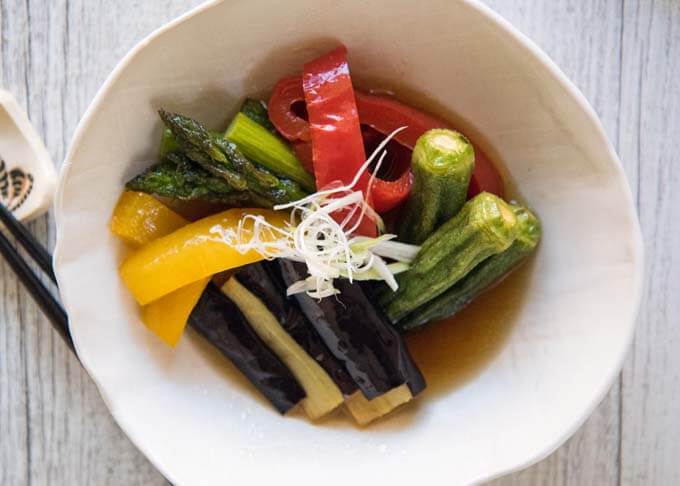
Yumiko![]()
P.S. Don’t forget to see the section ‘MEAL IDEAS’ below the recipe card! It gives you a list of dishes that I have already posted and the new recipe in this post that can make up a complete meal. I hope it is of help to you.
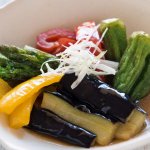
When deep fried vegetables are soaked in a soy sauce flavoured broth, the vegetables absorb the flavour from the broth and transform to a delicious dish. Although deep fried, Fried Vegetables in Broth is not oily at all.
It is a handy side dish or salad that you can prepare ahead of time.
Marinating Time is the minimum required.
- Oil to deep fry
- 80g/2.8oz okra (I had 8 okra)
- 80g/2.8oz yellow capsicum
- 80g/2.8oz red capsicum
- 80g/2.8oz asparagus
- 100g/3.5oz eggplant (note 2)
- 300ml/10oz dashi stock
- 2 tbsp soy sauce
- 1 tbsp mirin
- A pinch of salt
- Finely julienned shallots/scallions (white part), curled in ice water
-
Mix the Broth ingredients in a container with a lid that is large enough to fit all the vegetables snuggly.
-
Okra - trim the tip of the stem end. Run your knife around the stem end, where the stem and the pod meet, to remove the black line around the top of the pod (see the photo in the post). Stab the side of the pod to make a tiny incision.
-
Capsicum - remove the stem and seeds, then slice vertically to 1.5cm/⅝" wide strips.
-
Asparagus - trim ends and cut to about 5cm/2” long pieces.
-
Eggplant - trim the stem off. If using a short thin eggplant, cut it vertically to make 4-6 wedges. If the length of the wedges is much longer than 5cm/2”, cut them in half. If using a large eggplant, cut the piece in half vertically, then slice each piece vertically to 1cm/⅜” thickness.
-
Fill a frying pan with oil to about 1.5cm/⅝" deep and heat to 170C/338F.
-
Fry same ingredients together for about 1 minute, turning over half way. Fry vegetables in a few batches so the oil is not over-crowd (note 3).
-
Transfer the fried vegetables to a tray lined with kitchen paper to absorb oil. Then while still hot, transfer them to the broth. (note 4)
-
When all vegetables are placed in the broth, put the lid on and leave the container in the fridge for 30 minutes to a few hours (note 5).
-
Place a few pieces each of the different vegetables in an individual bowl or a plate (note 6), topped with a small quantity of julienned shallots/scallions if using.
1. You can use other vegetables that are good to deep fry. You can also reduce the number of different vegetables. Please see my post for suggested vegetables.
2. I used ⅓ of a large eggplant. But if you are using small eggplants, you can use whole ones.
3. Depending on the size of the frying pan, the amount of vegetables you can fry at once varies. If using a large frying pan, you can fry two kinds of vegetables together. Just ensure that the oil is not over-crowded.
4. I transfer the vegetables of the first batch while frying the second batch, then keep moving this way like a production line.
5. You can eat Fried Vegetables in Broth (Vegetables Agebitashi) after 30 minutes of marinating. But the flavour of the broth gets absorbed into vegetables and intensifies when the vegetables are marinated in the broth for a while. It is also great to eat cold vegetables when the weather is hot.
6. I placed the same vegetables together and spread out the different colours, but you can place them randomly if you wish.
7. Fried Vegetables in Broth (Vegetables Agebitashi) keeps 3 days in the fridge. But the colour of the eggplant skins fades away if left in the broth too long.
8. Nutrition per serving as a side. Assumed 40ml of oil is absorbed into vegetables, 20% of the broth is soaked into the vegetables which is probably overstated.
serving: 200g calories: 142kcal fat: 10g (15%) saturated fat: 0.8g (4%) trans fat: 0.1g polyunsaturated fat: 1.8g monounsaturated fat: 7g cholesterol: 0.7mg (0%) sodium: 593mg (25%) potassium: 435mg (12%) carbohydrates: 9.6g (3%) dietary fibre: 2.5g (10%) sugar: 5.2g protein: 4.2g vitamin a: 16% vitamin c: 172% calcium: 2.7% iron: 6.8%
Meal Ideas
A typical Japanese meal consists of a main dish, a couple of side dishes, a soup and rice. I try to come up with a combination of dishes with a variety of flavours, colours, textures and make-ahead dishes.
I think that Vegetables Agebitashi goes very well with plain grilled fish. Grilled Salted Salmon is a perfect match. To add a different flavour to the meal, I picked Seafood Nuta, which is dressed in vinegar flavoured miso dressing.
- Main: Japanese Salmon (Slated Salmon) – make ahead for marinating.
- Side dish 1: Fried Vegetables in Broth (Vegetables Agebitashi) – today’s recipe, make ahead.
- Side dish 2: Seafood Nuta (Miso Dressing) – either Tuna and Shallots/Scallions Nuta or Squid with Cucumber and Wakame Nuta.
- Soup: Miso Soup of your choice from Miso Soup Ingredient Combinations – or your favourite ingredients.
- Rice: Cooked Rice
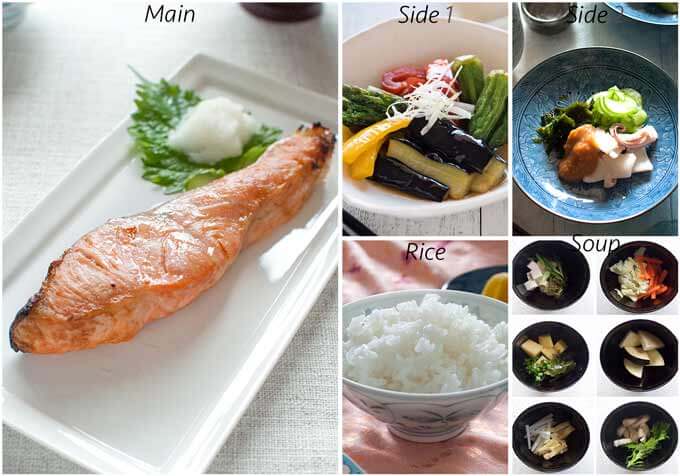
Leave a Reply